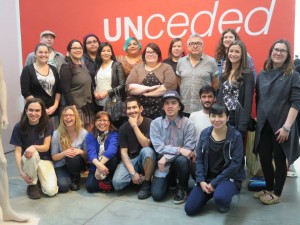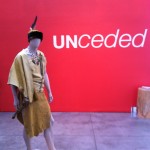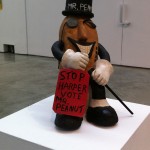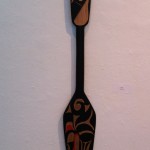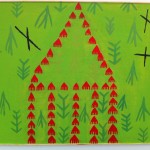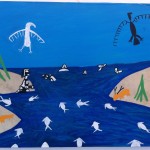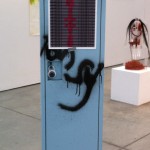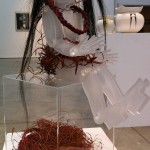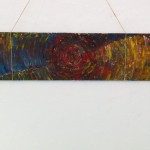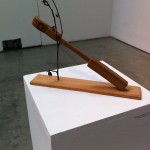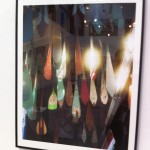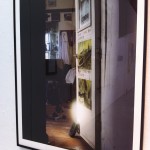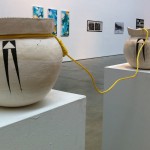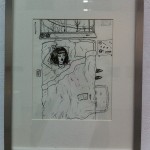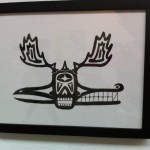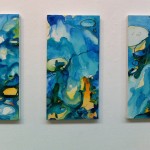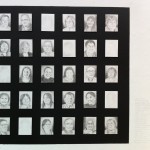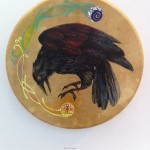Written by Karin Watson
Ceded is in some ways an unfamiliar term. It is used mainly in formal writing, relating to land and its transfer of ownership from one party to another. Very much a part of the BC Treaty process and its documents, the term means to give up, give over or give away. The exhibition’s curators, by choosing to explore its antonym, give expression to Aboriginal resilience and courage. Works in the show, however, step well beyond the bounds of land ownership and comment on any and all aspects of Aboriginal experience, arts practice, language and cultural practice.
The exhibition UNceded represents a careful consideration of, and inquiry into, those things which have not been appropriated, taken or misused. UNceded poses, and answers with many different voices as well as in unison, the question of “what remains?”
PERSPECTIVES ON THE EXHIBITION FROM A CO-CURATOR
“I suppose you could say I’m political by nature,” says co-curator and fourth year student lou-ann lka’wega Neel. ”But our purpose in an exhibition of this kind is really to consider anything in the social political world that we can comment on…bounce back…process at some level.”
Indeed, Lou-ann is no stranger to politics, nor to the language and expression surrounding Aboriginal affairs. She possesses a public service career, in both Provincial and Federal government, as a policy-writer, public administrator and seasoned advocate for Aboriginal arts, culture and language.
In co-curating UNceded, with William Callaghan and Richard Heikkila-Sawan , Lou-ann’s reflections were recorded days before the opening. While Lou-ann’s story certainly begs to be documented in much greater detail one day, we hope that to see the exhibition with preliminary insight to her personal perspectives, will provide one artist’s context and thereby enhance the transformative and courageous nature of this show and all its pieces for the viewer.
TWO JOBS, POLICY AND ART
Originally from Alert Bay, Lou-ann Ika’wega Neel still returns home for Potlatches whenever possible. She has done so throughout her professional life — a public service career that grew quickly, progressing from a light summer job within the EI office in the early ’80’s through to leadership and consulting roles within Aboriginal Affairs, Tourism, and the Friendship Centre, to name a few.
Lou-ann has always maintained a consistent creative practice, and was accomplished in textiles and Aboriginal design upon arrival at Emily Carr. Her lifelong interest in art is no surprise as, spectacularly, her grandmother was an accomplished carver in her own right, and the [female] artist behind the original Thunderbird totem pole at UBC. The first symbolic mascot in sports history, it was erected in 1948, then replaced through a restoration project led by her family including Lou-ann, in 2003.
With many artists in her family, Lou-ann says a degree was always on her “bucket list”. Once she realized that peoples’ degrees didn’t necessarily always relate to their work, she knew she wanted to come to Emily Carr University – she wanted to become a professional artist. “I cried when I got in – my sister will tell you that – and I’ll almost be finished by 50!” She now finds herself excited at the prospect of graduating this May with a degree in Visual Arts, majoring in sculpture.
While attending Emily Carr to complete her undergraduate degree, she continues to consult, delivering a program called Authentic Indigenous Arts, which focuses, perfectly, on art as business. Stay tuned for her personal website and web store where you may be able to purchase jewellery and textiles, including a line of deluxe linens inspired by designs commissioned last year for an Aboriginal hotel.
RELEVANCE AND EXPRESSION
As with her current consulting work’s relevance to her studies, Lou-ann’s public service career too has placed her first-hand into areas of direct relevance to this exhibition’s theme. In many positions she has made significant impacts, and influenced very directly, the nature and quality of Aboriginal programs and policies aimed at reclaiming a cultural voice among other significant elements that were ceded.
“At one point, I wrote a full cultural awareness workshop series and delivered it in Provincial Ministries–I could see how the policies I wanted to write weren’t necessarily in conflict with what had existed, but it was the voice I wanted to change and to elaborate differently.”
“I’ve always been fortunate to balance my ‘day job’s’ pressures with my creative practice. I always had two jobs — public administration and art. The one by day was complex with high pressure, but everything became crystal clear when I came home each night and immersed myself in my art. Creating all night helped me to work through the conflicts, to communicate more effectively.”
Courage, expression and self-expression are central to this exhibition as they are key for Lou-ann, and the older she gets, the less, she says, she worries. In her own words, “You’re entitled to think and so am I.” We hope to tell more of Lou-ann’s story, and those of many others in this year’s Aboriginal Student Art Exhibition.
